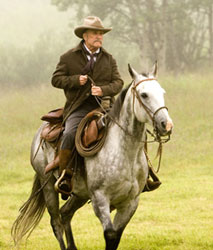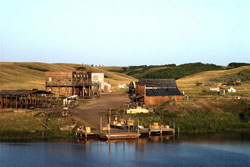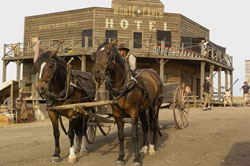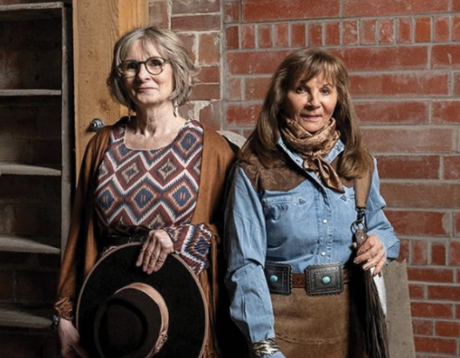Shooting the Canadian West
 |
|
Photo courtesy of © 2005 Chris Large/AMC |
Nominated for 23 Emmy Awards, Bury My Heart at Wounded Knee, based on Dee Brown’s multi-award winning tome of the same name, dramatizes the non-fiction book about the decline of American First Nations peoples. At first, the movie location was reputed to be near and around Livingston, Montana, that is until HBO executives asked, “Why don’t you shoot it in Canada?”
Stunning scenery and experienced crews played a big part but at the time it may have also been an economic decision. Anyone looking to make a movie (or TV show or music video or commercial) can recoup 14 – 23% of their budget just by moving the production north across the Medicine Line. Why? Canada aggressively pursues the Hollywood dollar with tax breaks and other incentives. And it’s working.
Alberta productions received 36 nominations for the 2007 Emmy Awards. Broken Trail, the miniseries starring Robert Duvall, and Bury My Heart at Wounded Knee starring Adam Beach led the pack of Emmy nominees with a total of 23.
Broken Trail, shot in the vicinity of Longview, Alta., focuses on a close-of-the-19th-century horse drive from Oregon to Wyoming. Not only did it win Outstanding Mini Series, but Robert Duvall, who also produced the mini series, received an Emmy for Outstanding Lead Actor. “We had some of the greatest cowboys in the world,” said Duvall while accepting the Emmy. “It was great working in Alberta.”
 |
|
Photo courtesy of © 2007 Warner Bros. Entertainment Inc. |
It must have been music to the ears of Alberta’s Film Commissioner, Dan Chugg, who has been a driving force in marketing Alberta to Hollywood. Typically, Alberta Film puts together about 100 – 150 packages for producers looking at Alberta as a location. The moment they hear a rumour of say, a western, they promote hard, putting location packages together from a library of about 15,000 digital images.
The recently released The Assassination of Jesse James by the Coward Robert Ford, starring Brad Pitt required years of work behind the scenes. “We worked on that for more than a year and a half to bring (the production) to Alberta,” said Chugg. While piquing the interest of the execs was made a bit easier by their familiarity with Alberta due to such films as Legends of the Fall and Unforgiven, each script requires specific locations and literally thousands of images were included in the “most comprehensive marketing” on a specific project they’ve ever done.
With Jesse James, Chugg related their biggest challenge; the robbery scene with the old train. “In the director’s mind it was very specific,” explained Chugg. “It had to be on a bend with a cut bank on the right side for 15 or 30 feet; drop away for another 10 – 15 feet and we had to get the right (train) engine. That was our biggest challenge, and wouldn’t you know it, we looked at thousands of miles of track and then all of a sudden, take them to Fort Edmonton and there’s the exact curve with the old train sitting in Fort Edmonton,” he laughed.
Fort Edmonton was the location for the first five weeks of shooting, and the remainder of the six months was shot all across southern Alberta, including the Bow River Ranch.
 |
|
Photo courtesy of © 2007 Warner Bros. Entertainment Inc. |
Location is everything, and Alberta is always interested in “good locations that are unique, film friendly and have good access,” confirms Chugg. Currently, the province boasts about 26 standing or period sets (including Fort Edmonton and Heritage Park in Calgary.)
Saskatchewan is also hot on the trail of movie production and it scored big with the shooting of the soon to be aired The Englishman’s Boy.
“I read The Englishman’s Boy in one sitting and called Guy’s (author Guy Vanderhaeghe) agent the minute I put it down,” remembers executive producer Kevin DeWalt of Minds Eye Entertainment. “That was almost 10 years ago. I must have been number 30 in line for the option but I was passionate and tenacious.”
His tenacity paid off. Vanderhaeghe adapted his Governor General Award-winning novel as a two-part, four-hour mini-series to air on CBC Television, directed by John N. Smith (The Boys of St. Vincent, Prairie Giant: The Tommy Douglas Story). Locations were scouted, set construction began, cowboy camp was set up and they were ready to shoot in the summer of 2006.
 |
|
Photo courtesy of Minds Eye Entertainment |
“The story was so filmic, the dialogue was so powerful – I had to do it,” explained DeWalt. “And, I had to do it in Saskatchewan. The story comes from this land. We had to see that on screen.”
Authentic locations were no problem in Saskatchewan, but authenticity in the actors was a concern.
“In order for this film to flow and have the scope and impact we wanted, our 1873 actors simply had to be comfortable with and on horses,” explains John Smith. “I went to the (T. J. Bews) wranglers and said, ‘OK, how do we make this happen?’ They suggested cowboy camp.” During the morning, the actors saddled, brushed, rode and swam with the horses and in the afternoon, they rehearsed. In the evening, the actors went back to the wranglers’ camp.
“By the end of two weeks, those guys could ride. Really ride,” said Smith. “They had also become a band. They had melded into the posse.”
“Not only were we learning to ride, we were rehearsing,” explains Dylan Scott Smith (Ed Grace). “Of course, every one of us had his hat blown off – the penalty for that was a case of beer for the wranglers.”
 |
|
|
 |
|
Photos courtesy of Minds Eye Entertainment |
“I was scared as hell,” admits Stephen Park, who plays Scotty McDougal. “It was quite intimidating, really. My horse was in Brokeback Mountain. His resume is more impressive than mine.”
The film crew constructed the western frontier “world” a mere 50 kilometres from Regina on private land between the rural communities of Earl Grey and Southey, and it was built to last. “We intend to leave the set standing at the completion of shooting, so it can be used as the basis for Saskatchewan’s first studio back lot,” explained DeWalt.
The crew also used various other locations to film specific scenes. The river crossing scene, for example, was filmed on Keith Houston’s ranch.
Meanwhile, back in Alberta, Chugg is busy selling what he calls the Alberta “value proposition”. “Our crews have been winning more awards than anybody else – literally,” he enthused. “At the Emmy’s we had thirty-six nominations for movies shot in Alberta last year. That’s unheard of. Alberta has actually more Academy Award™ nominations than any other province. We have exceptional people, we’ve got the expertise and plus, we’ve got something a lot of places don’t have; film-friendly communities.”
Chugg and his team have made present- ations to over 250 communities and over 100 of them have taken the “Best Practices” workshop, a primer on how to attract and as importantly, how to prepare for the impact when the crew arrives. “When you get a little community and 300 people arrive with 18-wheelers and they’re not ready,” Chugg explains, “their experience might not be as good as it should be.”
 |
|
Photo courtesy of HBO |
With all the talk of movie stars, awards and multi-million dollar production budgets, Chugg and his team have no illusions of resting on their laurels. “We don’t go out and visit with the stars,” he stated matter of factly. “Once they’re here in Alberta, we go on to the next one.”

















